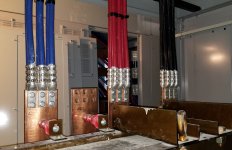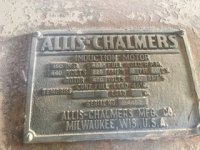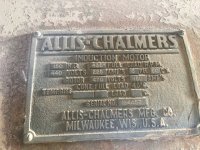Jpflex
Electrician big leagues
- Location
- Victorville
- Occupation
- Electrician commercial and residential
Hi I’m trying to get a general idea on feeder size for ball mill building.
The largest motor has two ampere ratings on nameplate for 3 phase 380 volt source one at 225 amperes and another for rotor current at 150 amperes. Since this is a low RPM motor under 1200 rpm code 430.6A says to use nameplate current rather than FLC based on Horsepower and NEC tables. I assume I go off of 225i ampere rating?
I’m not sure when you would go off of field current vs rotor current. Rotor current is merely induced voltage current from field.
When trying to figure out feeder I’m following NEC 430.24 for multiple motors and loads on a circuit
So far I have two identical large at 225 amperes with one being rated at 125% and the remaining motors at 100%
225i x 1.25 + 225 = 506.25 amperes so far
Plus
2 vat motors 7.5 of 3 phase with 11 FLC amperes each 2 x 11 = 22 amperes
6 more motors at 25 horsepower each or 34 FLC amperes each x 6 = 204 amperes
Ball mill general lighting VA based on outside dimensions 2485.02 sq ft x 1.7VA (workshop?) x 125% continuous load = 5281.28 VA
5281.28 va / 480v x 1.73(3 phase) = 6.35i amperes (Or do I go off of 120 v single phase voltage divider for lighting?)
Total all up = 738.6i amperes BUT table 310.16 only goes up to 665 amperes at 70 degree rating with 2000 kcmils
And there may be more motors being added
What do you do? Does this seem right so far?
The largest motor has two ampere ratings on nameplate for 3 phase 380 volt source one at 225 amperes and another for rotor current at 150 amperes. Since this is a low RPM motor under 1200 rpm code 430.6A says to use nameplate current rather than FLC based on Horsepower and NEC tables. I assume I go off of 225i ampere rating?
I’m not sure when you would go off of field current vs rotor current. Rotor current is merely induced voltage current from field.
When trying to figure out feeder I’m following NEC 430.24 for multiple motors and loads on a circuit
So far I have two identical large at 225 amperes with one being rated at 125% and the remaining motors at 100%
225i x 1.25 + 225 = 506.25 amperes so far
Plus
2 vat motors 7.5 of 3 phase with 11 FLC amperes each 2 x 11 = 22 amperes
6 more motors at 25 horsepower each or 34 FLC amperes each x 6 = 204 amperes
Ball mill general lighting VA based on outside dimensions 2485.02 sq ft x 1.7VA (workshop?) x 125% continuous load = 5281.28 VA
5281.28 va / 480v x 1.73(3 phase) = 6.35i amperes (Or do I go off of 120 v single phase voltage divider for lighting?)
Total all up = 738.6i amperes BUT table 310.16 only goes up to 665 amperes at 70 degree rating with 2000 kcmils
And there may be more motors being added
What do you do? Does this seem right so far?




